Ethics and Social Responsibility Report: Leadership Analysis
VerifiedAdded on 2021/06/18
|10
|2053
|46
Report
AI Summary
This report delves into the critical intersection of ethics and social responsibility within organizational contexts, focusing on the influence of leadership styles. It explores how transformational leadership can address ethical dilemmas and promote employee well-being. The report analyzes the leadership of Tim Cook at Apple Inc., highlighting his impact on organizational operations and employee engagement. It examines the leader's role in fostering communication, addressing employee needs, and promoting a socially responsible environment. Furthermore, the report proposes an action plan with SMART goals to enhance communication, employee engagement, and overall organizational performance, emphasizing the importance of ethical considerations in business practices. This report underscores the significance of leadership in shaping a company's ethical framework and social responsibility initiatives, with the objective of creating a sustainable and ethically sound business environment.
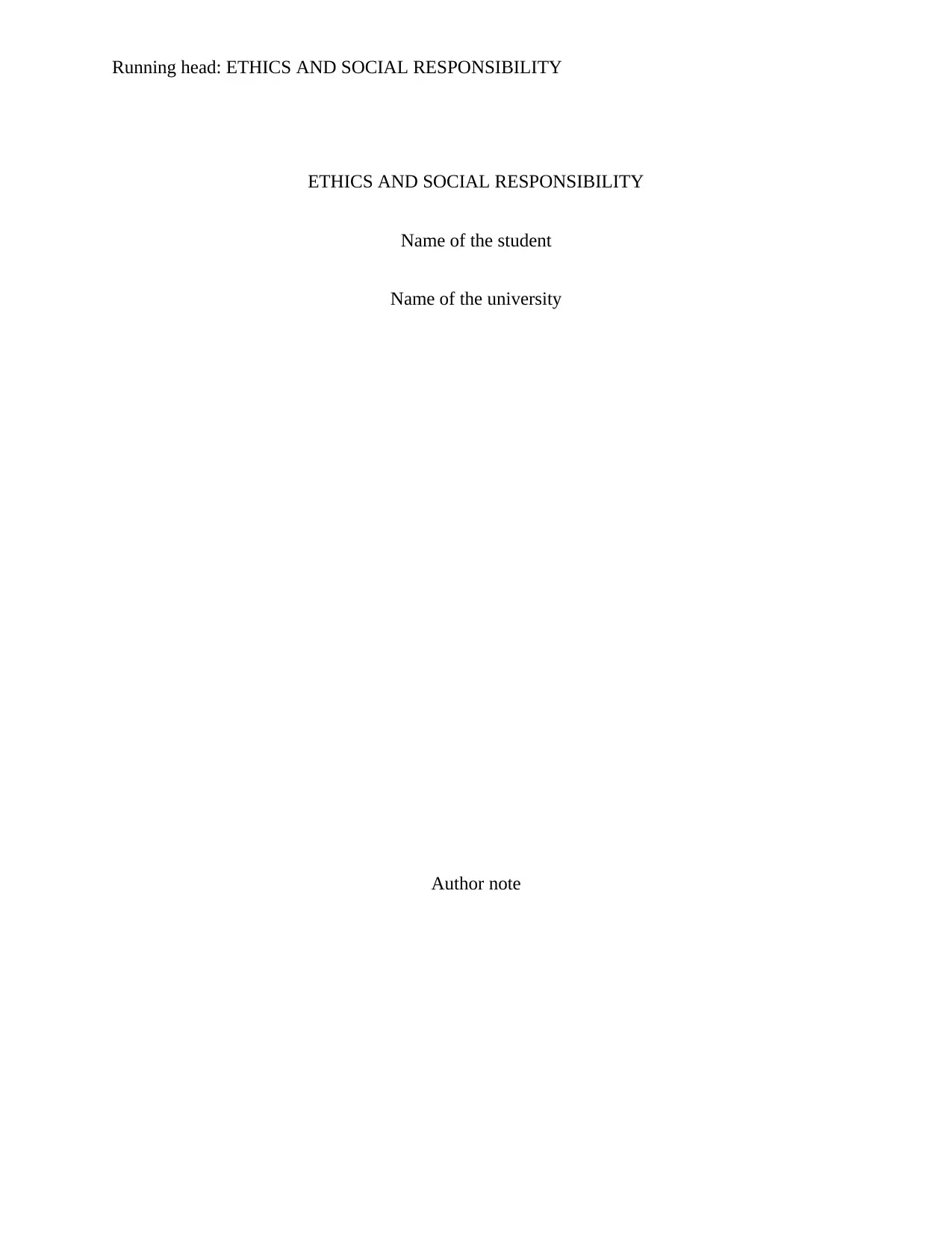
Running head: ETHICS AND SOCIAL RESPONSIBILITY
ETHICS AND SOCIAL RESPONSIBILITY
Name of the student
Name of the university
Author note
ETHICS AND SOCIAL RESPONSIBILITY
Name of the student
Name of the university
Author note
Paraphrase This Document
Need a fresh take? Get an instant paraphrase of this document with our AI Paraphraser
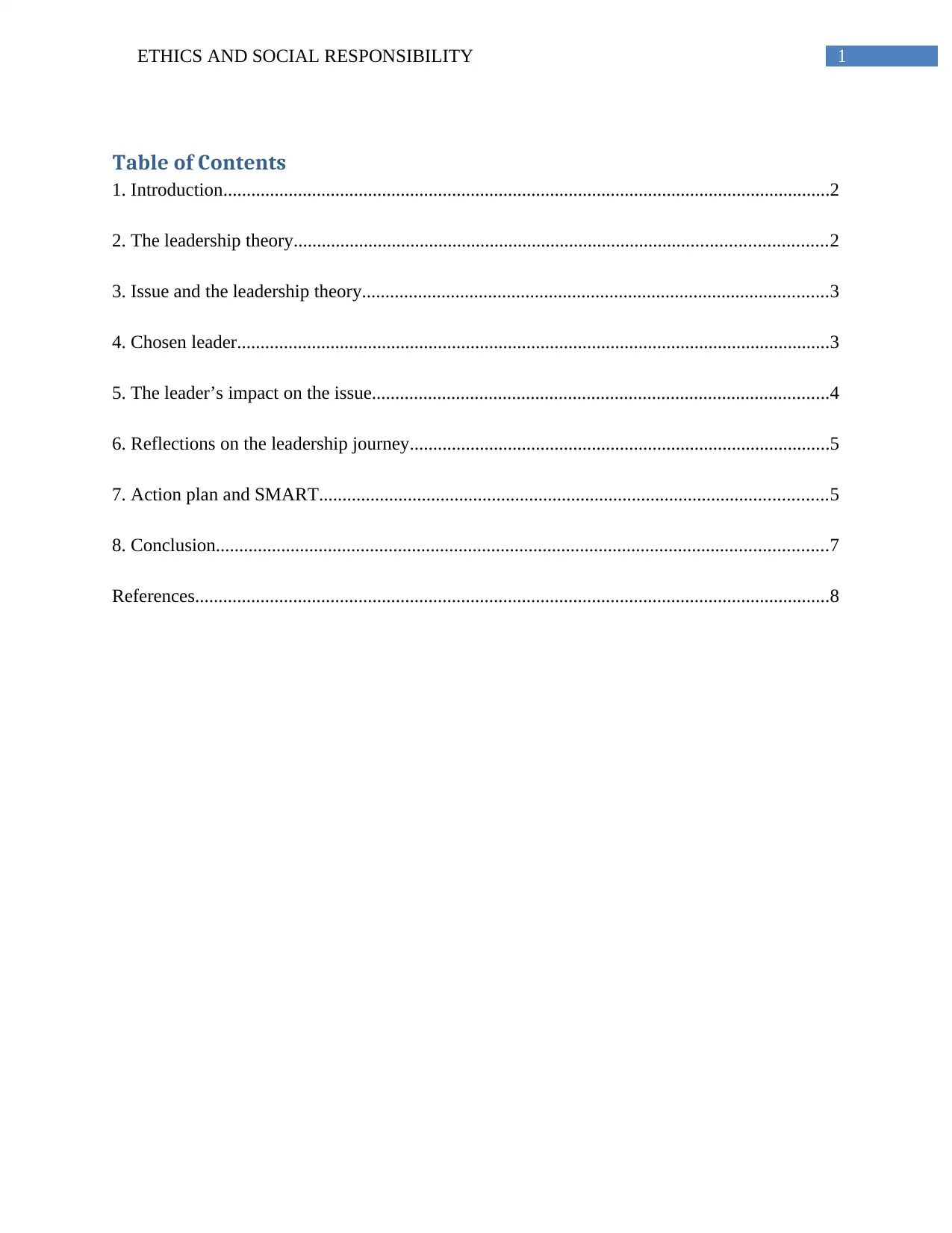
1ETHICS AND SOCIAL RESPONSIBILITY
Table of Contents
1. Introduction..................................................................................................................................2
2. The leadership theory..................................................................................................................2
3. Issue and the leadership theory....................................................................................................3
4. Chosen leader...............................................................................................................................3
5. The leader’s impact on the issue..................................................................................................4
6. Reflections on the leadership journey..........................................................................................5
7. Action plan and SMART.............................................................................................................5
8. Conclusion...................................................................................................................................7
References........................................................................................................................................8
Table of Contents
1. Introduction..................................................................................................................................2
2. The leadership theory..................................................................................................................2
3. Issue and the leadership theory....................................................................................................3
4. Chosen leader...............................................................................................................................3
5. The leader’s impact on the issue..................................................................................................4
6. Reflections on the leadership journey..........................................................................................5
7. Action plan and SMART.............................................................................................................5
8. Conclusion...................................................................................................................................7
References........................................................................................................................................8
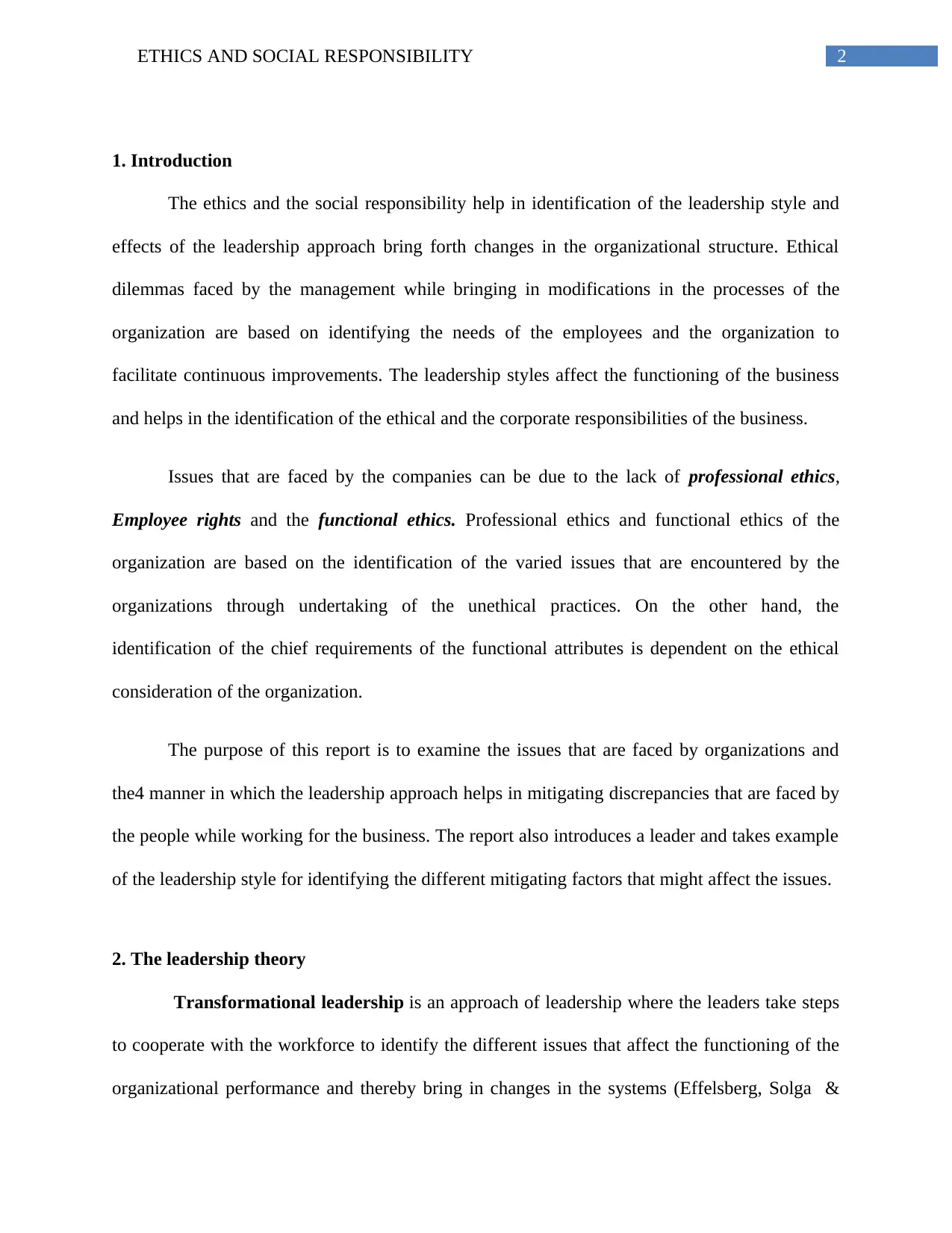
2ETHICS AND SOCIAL RESPONSIBILITY
1. Introduction
The ethics and the social responsibility help in identification of the leadership style and
effects of the leadership approach bring forth changes in the organizational structure. Ethical
dilemmas faced by the management while bringing in modifications in the processes of the
organization are based on identifying the needs of the employees and the organization to
facilitate continuous improvements. The leadership styles affect the functioning of the business
and helps in the identification of the ethical and the corporate responsibilities of the business.
Issues that are faced by the companies can be due to the lack of professional ethics,
Employee rights and the functional ethics. Professional ethics and functional ethics of the
organization are based on the identification of the varied issues that are encountered by the
organizations through undertaking of the unethical practices. On the other hand, the
identification of the chief requirements of the functional attributes is dependent on the ethical
consideration of the organization.
The purpose of this report is to examine the issues that are faced by organizations and
the4 manner in which the leadership approach helps in mitigating discrepancies that are faced by
the people while working for the business. The report also introduces a leader and takes example
of the leadership style for identifying the different mitigating factors that might affect the issues.
2. The leadership theory
Transformational leadership is an approach of leadership where the leaders take steps
to cooperate with the workforce to identify the different issues that affect the functioning of the
organizational performance and thereby bring in changes in the systems (Effelsberg, Solga &
1. Introduction
The ethics and the social responsibility help in identification of the leadership style and
effects of the leadership approach bring forth changes in the organizational structure. Ethical
dilemmas faced by the management while bringing in modifications in the processes of the
organization are based on identifying the needs of the employees and the organization to
facilitate continuous improvements. The leadership styles affect the functioning of the business
and helps in the identification of the ethical and the corporate responsibilities of the business.
Issues that are faced by the companies can be due to the lack of professional ethics,
Employee rights and the functional ethics. Professional ethics and functional ethics of the
organization are based on the identification of the varied issues that are encountered by the
organizations through undertaking of the unethical practices. On the other hand, the
identification of the chief requirements of the functional attributes is dependent on the ethical
consideration of the organization.
The purpose of this report is to examine the issues that are faced by organizations and
the4 manner in which the leadership approach helps in mitigating discrepancies that are faced by
the people while working for the business. The report also introduces a leader and takes example
of the leadership style for identifying the different mitigating factors that might affect the issues.
2. The leadership theory
Transformational leadership is an approach of leadership where the leaders take steps
to cooperate with the workforce to identify the different issues that affect the functioning of the
organizational performance and thereby bring in changes in the systems (Effelsberg, Solga &
⊘ This is a preview!⊘
Do you want full access?
Subscribe today to unlock all pages.

Trusted by 1+ million students worldwide
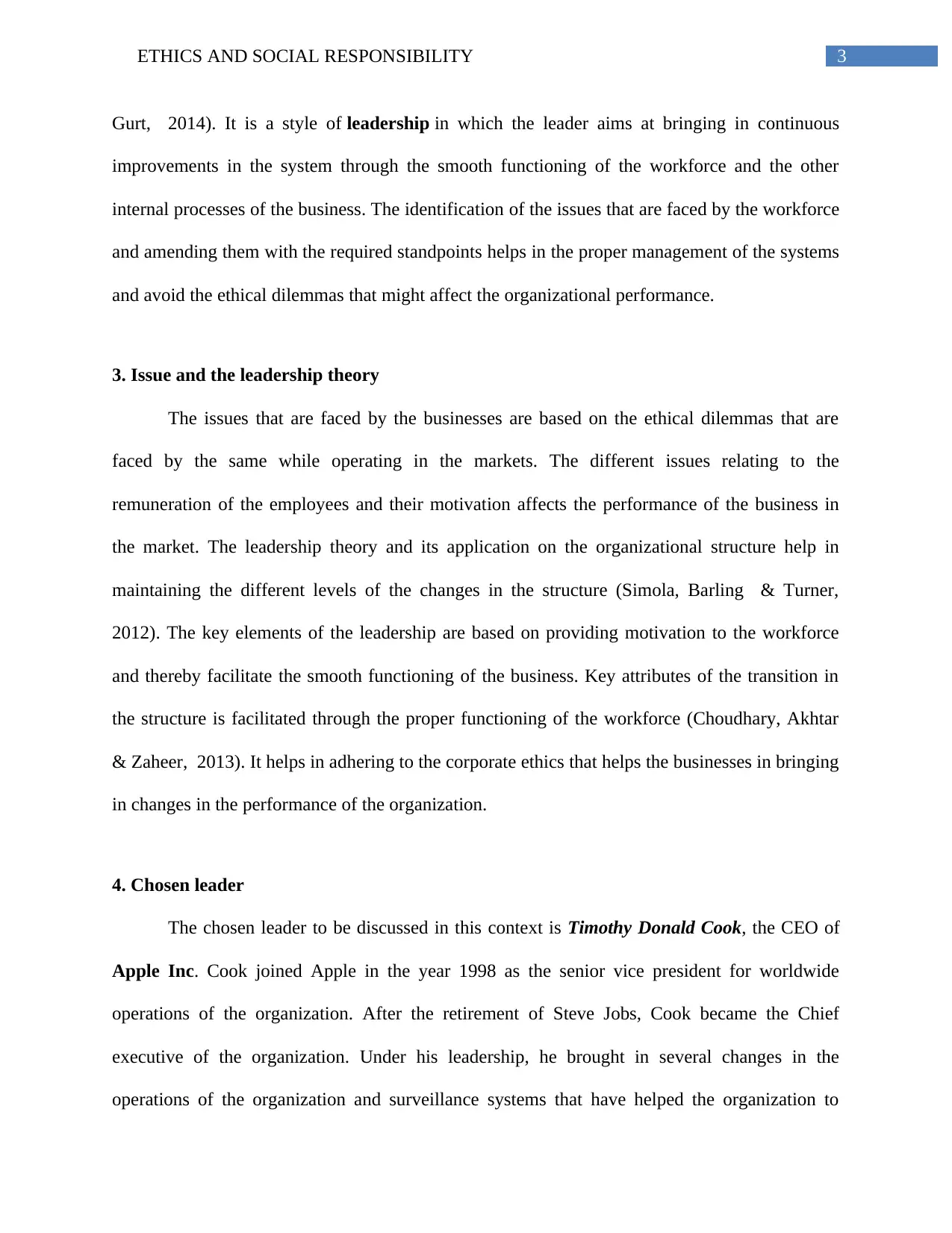
3ETHICS AND SOCIAL RESPONSIBILITY
Gurt, 2014). It is a style of leadership in which the leader aims at bringing in continuous
improvements in the system through the smooth functioning of the workforce and the other
internal processes of the business. The identification of the issues that are faced by the workforce
and amending them with the required standpoints helps in the proper management of the systems
and avoid the ethical dilemmas that might affect the organizational performance.
3. Issue and the leadership theory
The issues that are faced by the businesses are based on the ethical dilemmas that are
faced by the same while operating in the markets. The different issues relating to the
remuneration of the employees and their motivation affects the performance of the business in
the market. The leadership theory and its application on the organizational structure help in
maintaining the different levels of the changes in the structure (Simola, Barling & Turner,
2012). The key elements of the leadership are based on providing motivation to the workforce
and thereby facilitate the smooth functioning of the business. Key attributes of the transition in
the structure is facilitated through the proper functioning of the workforce (Choudhary, Akhtar
& Zaheer, 2013). It helps in adhering to the corporate ethics that helps the businesses in bringing
in changes in the performance of the organization.
4. Chosen leader
The chosen leader to be discussed in this context is Timothy Donald Cook, the CEO of
Apple Inc. Cook joined Apple in the year 1998 as the senior vice president for worldwide
operations of the organization. After the retirement of Steve Jobs, Cook became the Chief
executive of the organization. Under his leadership, he brought in several changes in the
operations of the organization and surveillance systems that have helped the organization to
Gurt, 2014). It is a style of leadership in which the leader aims at bringing in continuous
improvements in the system through the smooth functioning of the workforce and the other
internal processes of the business. The identification of the issues that are faced by the workforce
and amending them with the required standpoints helps in the proper management of the systems
and avoid the ethical dilemmas that might affect the organizational performance.
3. Issue and the leadership theory
The issues that are faced by the businesses are based on the ethical dilemmas that are
faced by the same while operating in the markets. The different issues relating to the
remuneration of the employees and their motivation affects the performance of the business in
the market. The leadership theory and its application on the organizational structure help in
maintaining the different levels of the changes in the structure (Simola, Barling & Turner,
2012). The key elements of the leadership are based on providing motivation to the workforce
and thereby facilitate the smooth functioning of the business. Key attributes of the transition in
the structure is facilitated through the proper functioning of the workforce (Choudhary, Akhtar
& Zaheer, 2013). It helps in adhering to the corporate ethics that helps the businesses in bringing
in changes in the performance of the organization.
4. Chosen leader
The chosen leader to be discussed in this context is Timothy Donald Cook, the CEO of
Apple Inc. Cook joined Apple in the year 1998 as the senior vice president for worldwide
operations of the organization. After the retirement of Steve Jobs, Cook became the Chief
executive of the organization. Under his leadership, he brought in several changes in the
operations of the organization and surveillance systems that have helped the organization to
Paraphrase This Document
Need a fresh take? Get an instant paraphrase of this document with our AI Paraphraser
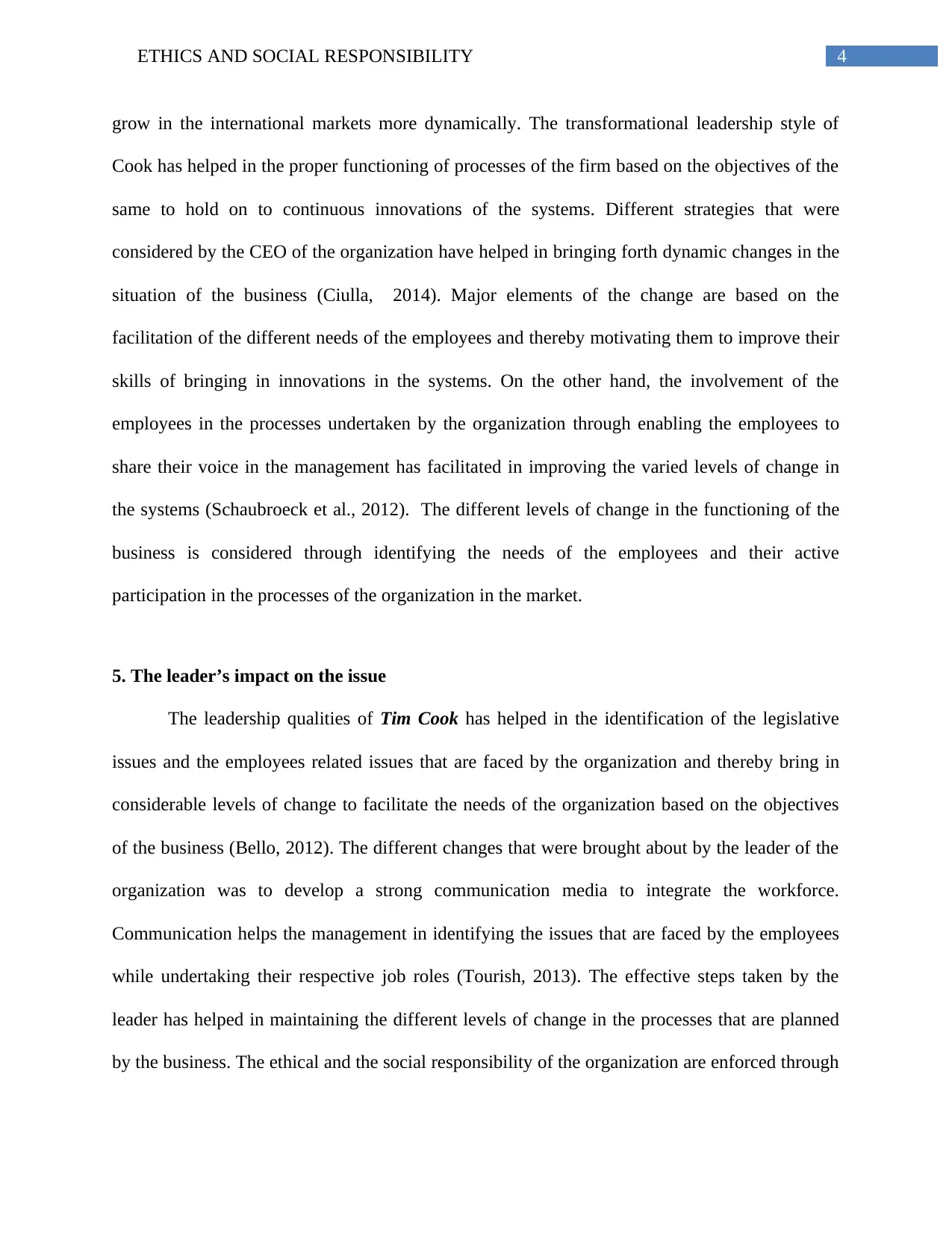
4ETHICS AND SOCIAL RESPONSIBILITY
grow in the international markets more dynamically. The transformational leadership style of
Cook has helped in the proper functioning of processes of the firm based on the objectives of the
same to hold on to continuous innovations of the systems. Different strategies that were
considered by the CEO of the organization have helped in bringing forth dynamic changes in the
situation of the business (Ciulla, 2014). Major elements of the change are based on the
facilitation of the different needs of the employees and thereby motivating them to improve their
skills of bringing in innovations in the systems. On the other hand, the involvement of the
employees in the processes undertaken by the organization through enabling the employees to
share their voice in the management has facilitated in improving the varied levels of change in
the systems (Schaubroeck et al., 2012). The different levels of change in the functioning of the
business is considered through identifying the needs of the employees and their active
participation in the processes of the organization in the market.
5. The leader’s impact on the issue
The leadership qualities of Tim Cook has helped in the identification of the legislative
issues and the employees related issues that are faced by the organization and thereby bring in
considerable levels of change to facilitate the needs of the organization based on the objectives
of the business (Bello, 2012). The different changes that were brought about by the leader of the
organization was to develop a strong communication media to integrate the workforce.
Communication helps the management in identifying the issues that are faced by the employees
while undertaking their respective job roles (Tourish, 2013). The effective steps taken by the
leader has helped in maintaining the different levels of change in the processes that are planned
by the business. The ethical and the social responsibility of the organization are enforced through
grow in the international markets more dynamically. The transformational leadership style of
Cook has helped in the proper functioning of processes of the firm based on the objectives of the
same to hold on to continuous innovations of the systems. Different strategies that were
considered by the CEO of the organization have helped in bringing forth dynamic changes in the
situation of the business (Ciulla, 2014). Major elements of the change are based on the
facilitation of the different needs of the employees and thereby motivating them to improve their
skills of bringing in innovations in the systems. On the other hand, the involvement of the
employees in the processes undertaken by the organization through enabling the employees to
share their voice in the management has facilitated in improving the varied levels of change in
the systems (Schaubroeck et al., 2012). The different levels of change in the functioning of the
business is considered through identifying the needs of the employees and their active
participation in the processes of the organization in the market.
5. The leader’s impact on the issue
The leadership qualities of Tim Cook has helped in the identification of the legislative
issues and the employees related issues that are faced by the organization and thereby bring in
considerable levels of change to facilitate the needs of the organization based on the objectives
of the business (Bello, 2012). The different changes that were brought about by the leader of the
organization was to develop a strong communication media to integrate the workforce.
Communication helps the management in identifying the issues that are faced by the employees
while undertaking their respective job roles (Tourish, 2013). The effective steps taken by the
leader has helped in maintaining the different levels of change in the processes that are planned
by the business. The ethical and the social responsibility of the organization are enforced through
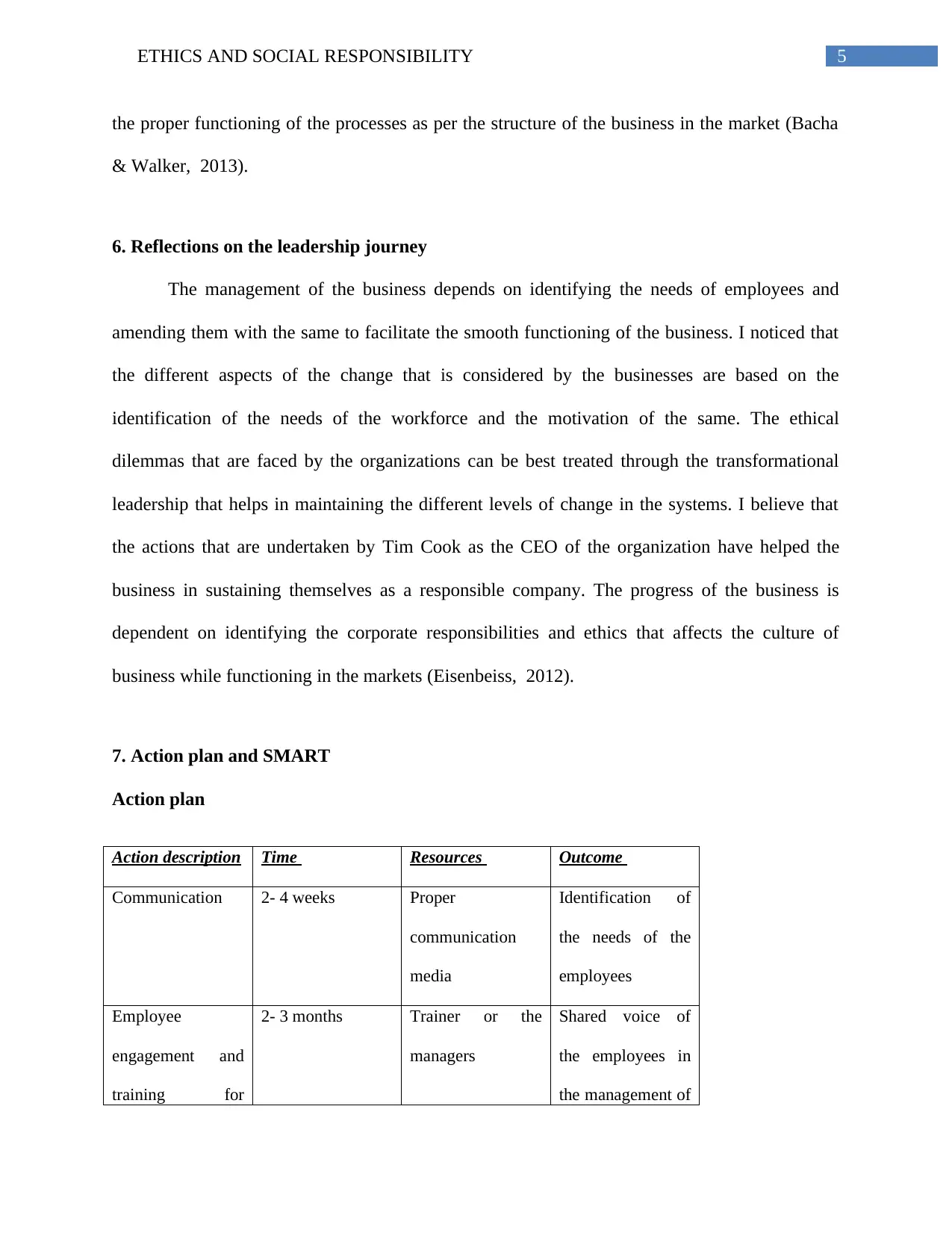
5ETHICS AND SOCIAL RESPONSIBILITY
the proper functioning of the processes as per the structure of the business in the market (Bacha
& Walker, 2013).
6. Reflections on the leadership journey
The management of the business depends on identifying the needs of employees and
amending them with the same to facilitate the smooth functioning of the business. I noticed that
the different aspects of the change that is considered by the businesses are based on the
identification of the needs of the workforce and the motivation of the same. The ethical
dilemmas that are faced by the organizations can be best treated through the transformational
leadership that helps in maintaining the different levels of change in the systems. I believe that
the actions that are undertaken by Tim Cook as the CEO of the organization have helped the
business in sustaining themselves as a responsible company. The progress of the business is
dependent on identifying the corporate responsibilities and ethics that affects the culture of
business while functioning in the markets (Eisenbeiss, 2012).
7. Action plan and SMART
Action plan
Action description Time Resources Outcome
Communication 2- 4 weeks Proper
communication
media
Identification of
the needs of the
employees
Employee
engagement and
training for
2- 3 months Trainer or the
managers
Shared voice of
the employees in
the management of
the proper functioning of the processes as per the structure of the business in the market (Bacha
& Walker, 2013).
6. Reflections on the leadership journey
The management of the business depends on identifying the needs of employees and
amending them with the same to facilitate the smooth functioning of the business. I noticed that
the different aspects of the change that is considered by the businesses are based on the
identification of the needs of the workforce and the motivation of the same. The ethical
dilemmas that are faced by the organizations can be best treated through the transformational
leadership that helps in maintaining the different levels of change in the systems. I believe that
the actions that are undertaken by Tim Cook as the CEO of the organization have helped the
business in sustaining themselves as a responsible company. The progress of the business is
dependent on identifying the corporate responsibilities and ethics that affects the culture of
business while functioning in the markets (Eisenbeiss, 2012).
7. Action plan and SMART
Action plan
Action description Time Resources Outcome
Communication 2- 4 weeks Proper
communication
media
Identification of
the needs of the
employees
Employee
engagement and
training for
2- 3 months Trainer or the
managers
Shared voice of
the employees in
the management of
⊘ This is a preview!⊘
Do you want full access?
Subscribe today to unlock all pages.

Trusted by 1+ million students worldwide
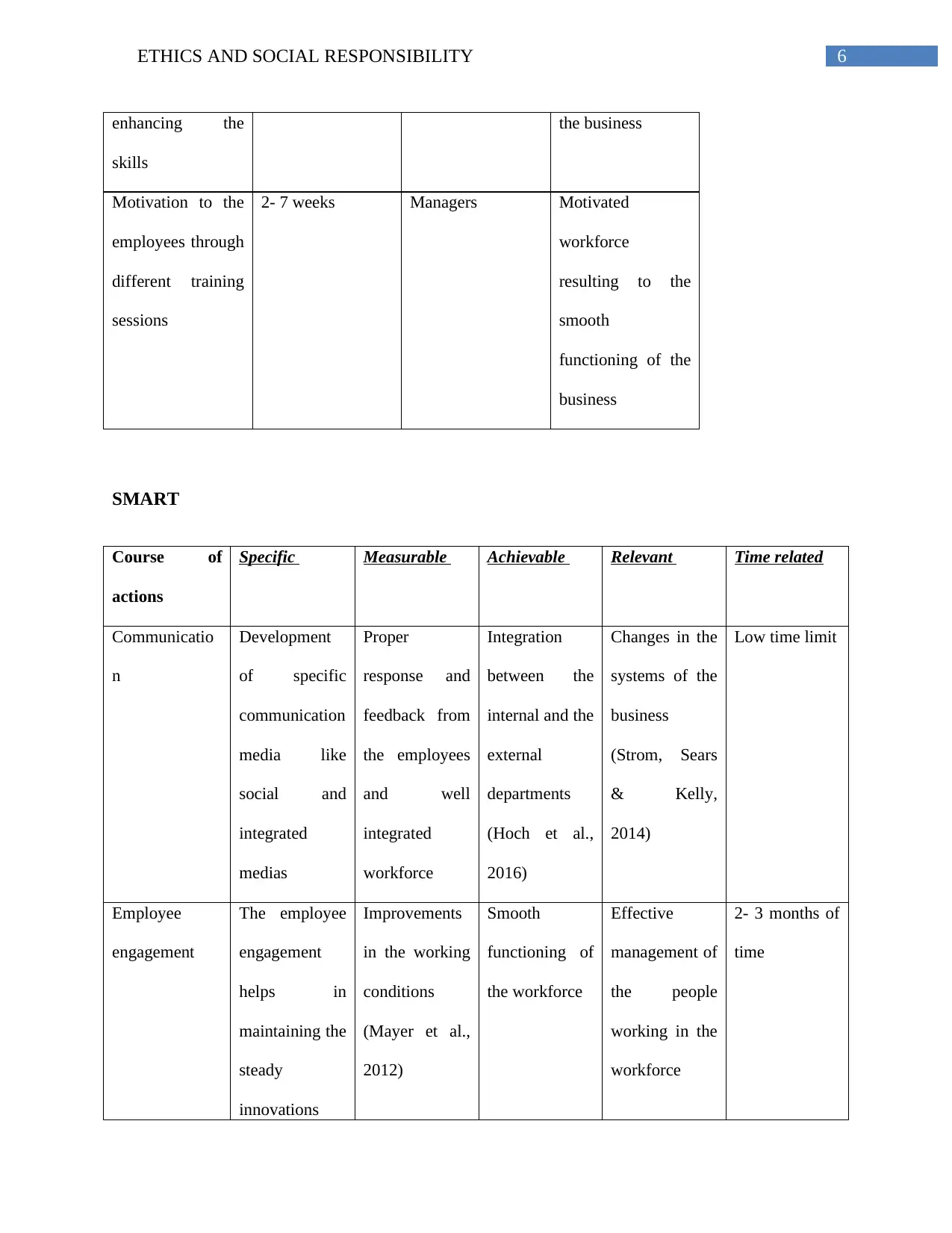
6ETHICS AND SOCIAL RESPONSIBILITY
enhancing the
skills
the business
Motivation to the
employees through
different training
sessions
2- 7 weeks Managers Motivated
workforce
resulting to the
smooth
functioning of the
business
SMART
Course of
actions
Specific Measurable Achievable Relevant Time related
Communicatio
n
Development
of specific
communication
media like
social and
integrated
medias
Proper
response and
feedback from
the employees
and well
integrated
workforce
Integration
between the
internal and the
external
departments
(Hoch et al.,
2016)
Changes in the
systems of the
business
(Strom, Sears
& Kelly,
2014)
Low time limit
Employee
engagement
The employee
engagement
helps in
maintaining the
steady
innovations
Improvements
in the working
conditions
(Mayer et al.,
2012)
Smooth
functioning of
the workforce
Effective
management of
the people
working in the
workforce
2- 3 months of
time
enhancing the
skills
the business
Motivation to the
employees through
different training
sessions
2- 7 weeks Managers Motivated
workforce
resulting to the
smooth
functioning of the
business
SMART
Course of
actions
Specific Measurable Achievable Relevant Time related
Communicatio
n
Development
of specific
communication
media like
social and
integrated
medias
Proper
response and
feedback from
the employees
and well
integrated
workforce
Integration
between the
internal and the
external
departments
(Hoch et al.,
2016)
Changes in the
systems of the
business
(Strom, Sears
& Kelly,
2014)
Low time limit
Employee
engagement
The employee
engagement
helps in
maintaining the
steady
innovations
Improvements
in the working
conditions
(Mayer et al.,
2012)
Smooth
functioning of
the workforce
Effective
management of
the people
working in the
workforce
2- 3 months of
time
Paraphrase This Document
Need a fresh take? Get an instant paraphrase of this document with our AI Paraphraser
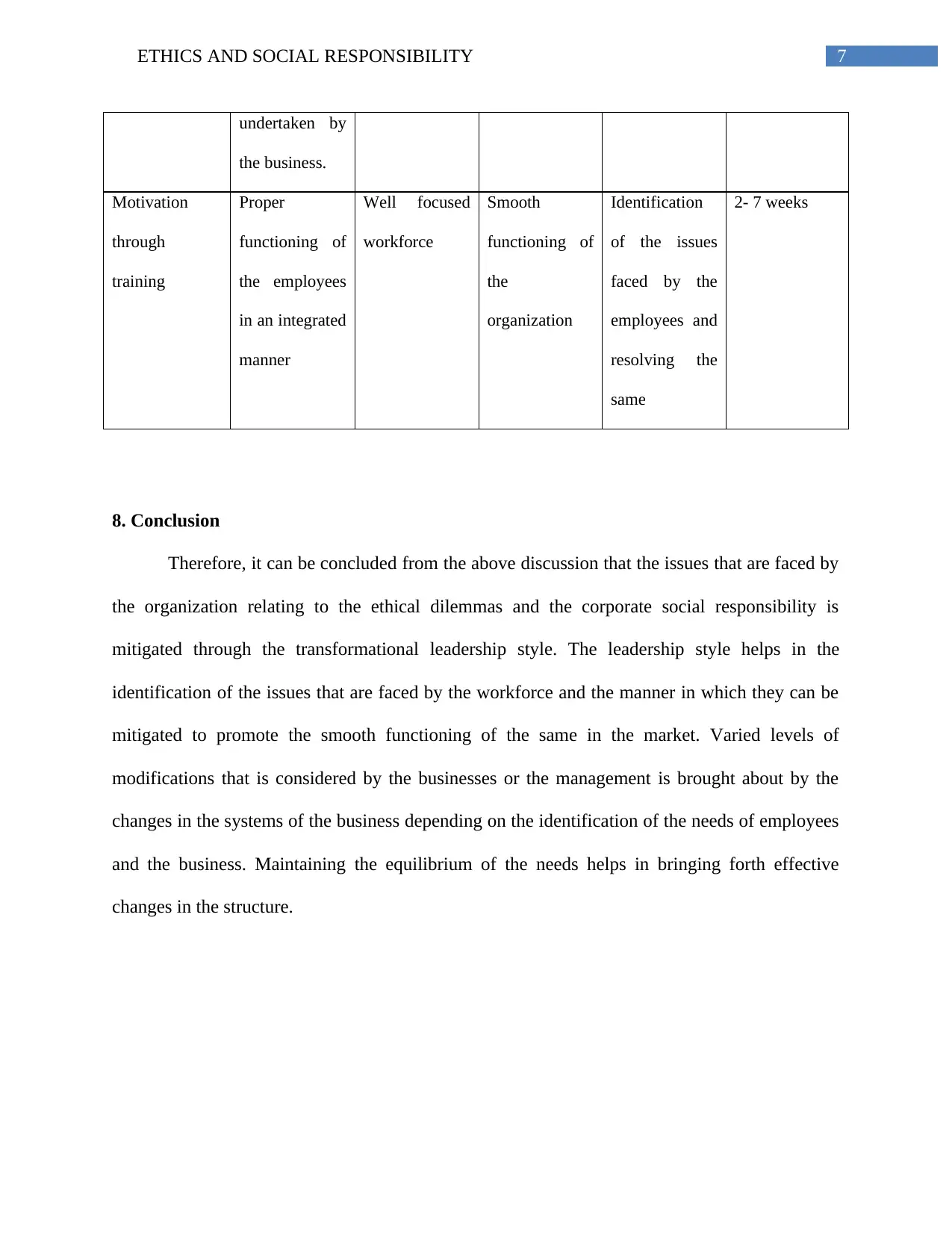
7ETHICS AND SOCIAL RESPONSIBILITY
undertaken by
the business.
Motivation
through
training
Proper
functioning of
the employees
in an integrated
manner
Well focused
workforce
Smooth
functioning of
the
organization
Identification
of the issues
faced by the
employees and
resolving the
same
2- 7 weeks
8. Conclusion
Therefore, it can be concluded from the above discussion that the issues that are faced by
the organization relating to the ethical dilemmas and the corporate social responsibility is
mitigated through the transformational leadership style. The leadership style helps in the
identification of the issues that are faced by the workforce and the manner in which they can be
mitigated to promote the smooth functioning of the same in the market. Varied levels of
modifications that is considered by the businesses or the management is brought about by the
changes in the systems of the business depending on the identification of the needs of employees
and the business. Maintaining the equilibrium of the needs helps in bringing forth effective
changes in the structure.
undertaken by
the business.
Motivation
through
training
Proper
functioning of
the employees
in an integrated
manner
Well focused
workforce
Smooth
functioning of
the
organization
Identification
of the issues
faced by the
employees and
resolving the
same
2- 7 weeks
8. Conclusion
Therefore, it can be concluded from the above discussion that the issues that are faced by
the organization relating to the ethical dilemmas and the corporate social responsibility is
mitigated through the transformational leadership style. The leadership style helps in the
identification of the issues that are faced by the workforce and the manner in which they can be
mitigated to promote the smooth functioning of the same in the market. Varied levels of
modifications that is considered by the businesses or the management is brought about by the
changes in the systems of the business depending on the identification of the needs of employees
and the business. Maintaining the equilibrium of the needs helps in bringing forth effective
changes in the structure.
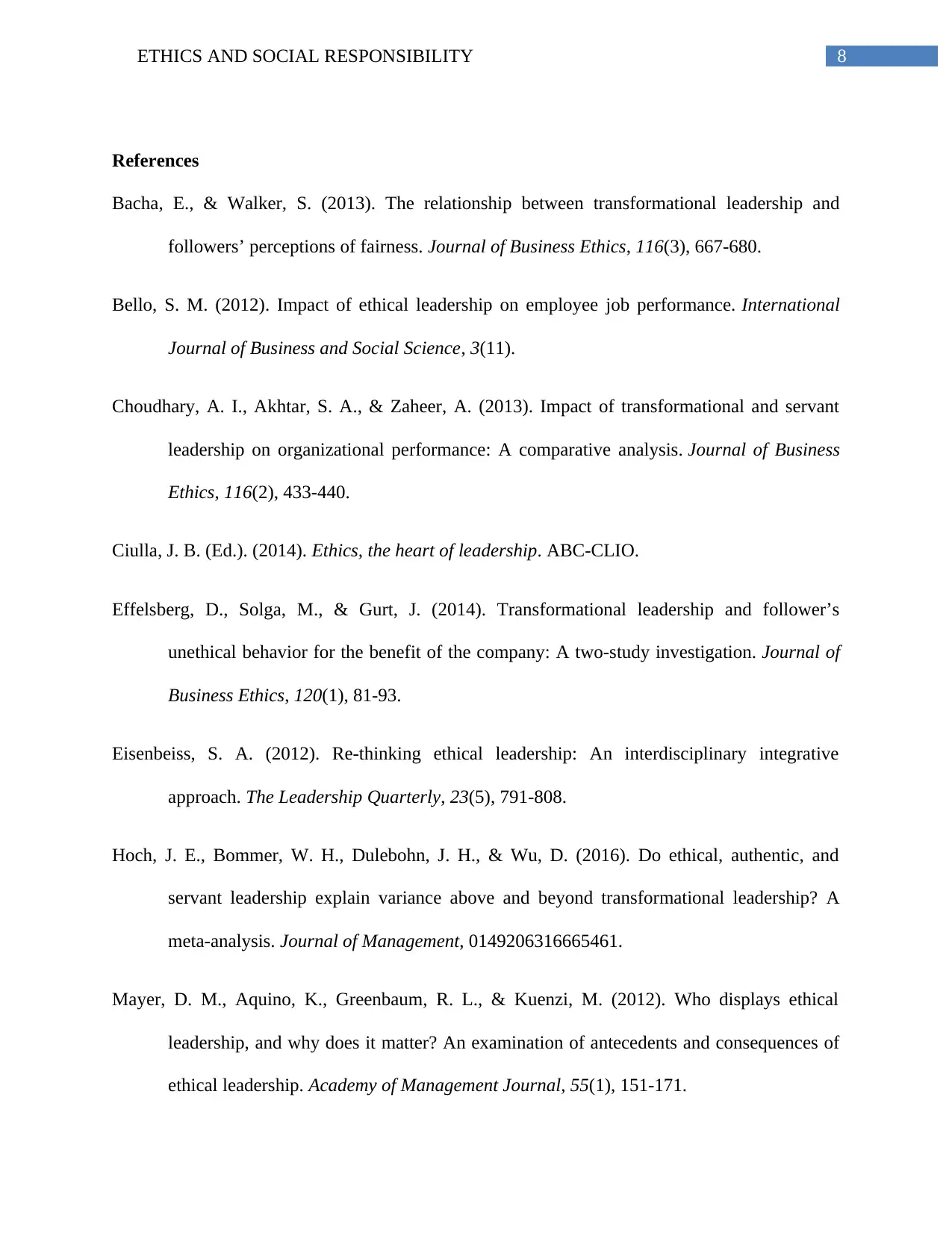
8ETHICS AND SOCIAL RESPONSIBILITY
References
Bacha, E., & Walker, S. (2013). The relationship between transformational leadership and
followers’ perceptions of fairness. Journal of Business Ethics, 116(3), 667-680.
Bello, S. M. (2012). Impact of ethical leadership on employee job performance. International
Journal of Business and Social Science, 3(11).
Choudhary, A. I., Akhtar, S. A., & Zaheer, A. (2013). Impact of transformational and servant
leadership on organizational performance: A comparative analysis. Journal of Business
Ethics, 116(2), 433-440.
Ciulla, J. B. (Ed.). (2014). Ethics, the heart of leadership. ABC-CLIO.
Effelsberg, D., Solga, M., & Gurt, J. (2014). Transformational leadership and follower’s
unethical behavior for the benefit of the company: A two-study investigation. Journal of
Business Ethics, 120(1), 81-93.
Eisenbeiss, S. A. (2012). Re-thinking ethical leadership: An interdisciplinary integrative
approach. The Leadership Quarterly, 23(5), 791-808.
Hoch, J. E., Bommer, W. H., Dulebohn, J. H., & Wu, D. (2016). Do ethical, authentic, and
servant leadership explain variance above and beyond transformational leadership? A
meta-analysis. Journal of Management, 0149206316665461.
Mayer, D. M., Aquino, K., Greenbaum, R. L., & Kuenzi, M. (2012). Who displays ethical
leadership, and why does it matter? An examination of antecedents and consequences of
ethical leadership. Academy of Management Journal, 55(1), 151-171.
References
Bacha, E., & Walker, S. (2013). The relationship between transformational leadership and
followers’ perceptions of fairness. Journal of Business Ethics, 116(3), 667-680.
Bello, S. M. (2012). Impact of ethical leadership on employee job performance. International
Journal of Business and Social Science, 3(11).
Choudhary, A. I., Akhtar, S. A., & Zaheer, A. (2013). Impact of transformational and servant
leadership on organizational performance: A comparative analysis. Journal of Business
Ethics, 116(2), 433-440.
Ciulla, J. B. (Ed.). (2014). Ethics, the heart of leadership. ABC-CLIO.
Effelsberg, D., Solga, M., & Gurt, J. (2014). Transformational leadership and follower’s
unethical behavior for the benefit of the company: A two-study investigation. Journal of
Business Ethics, 120(1), 81-93.
Eisenbeiss, S. A. (2012). Re-thinking ethical leadership: An interdisciplinary integrative
approach. The Leadership Quarterly, 23(5), 791-808.
Hoch, J. E., Bommer, W. H., Dulebohn, J. H., & Wu, D. (2016). Do ethical, authentic, and
servant leadership explain variance above and beyond transformational leadership? A
meta-analysis. Journal of Management, 0149206316665461.
Mayer, D. M., Aquino, K., Greenbaum, R. L., & Kuenzi, M. (2012). Who displays ethical
leadership, and why does it matter? An examination of antecedents and consequences of
ethical leadership. Academy of Management Journal, 55(1), 151-171.
⊘ This is a preview!⊘
Do you want full access?
Subscribe today to unlock all pages.

Trusted by 1+ million students worldwide
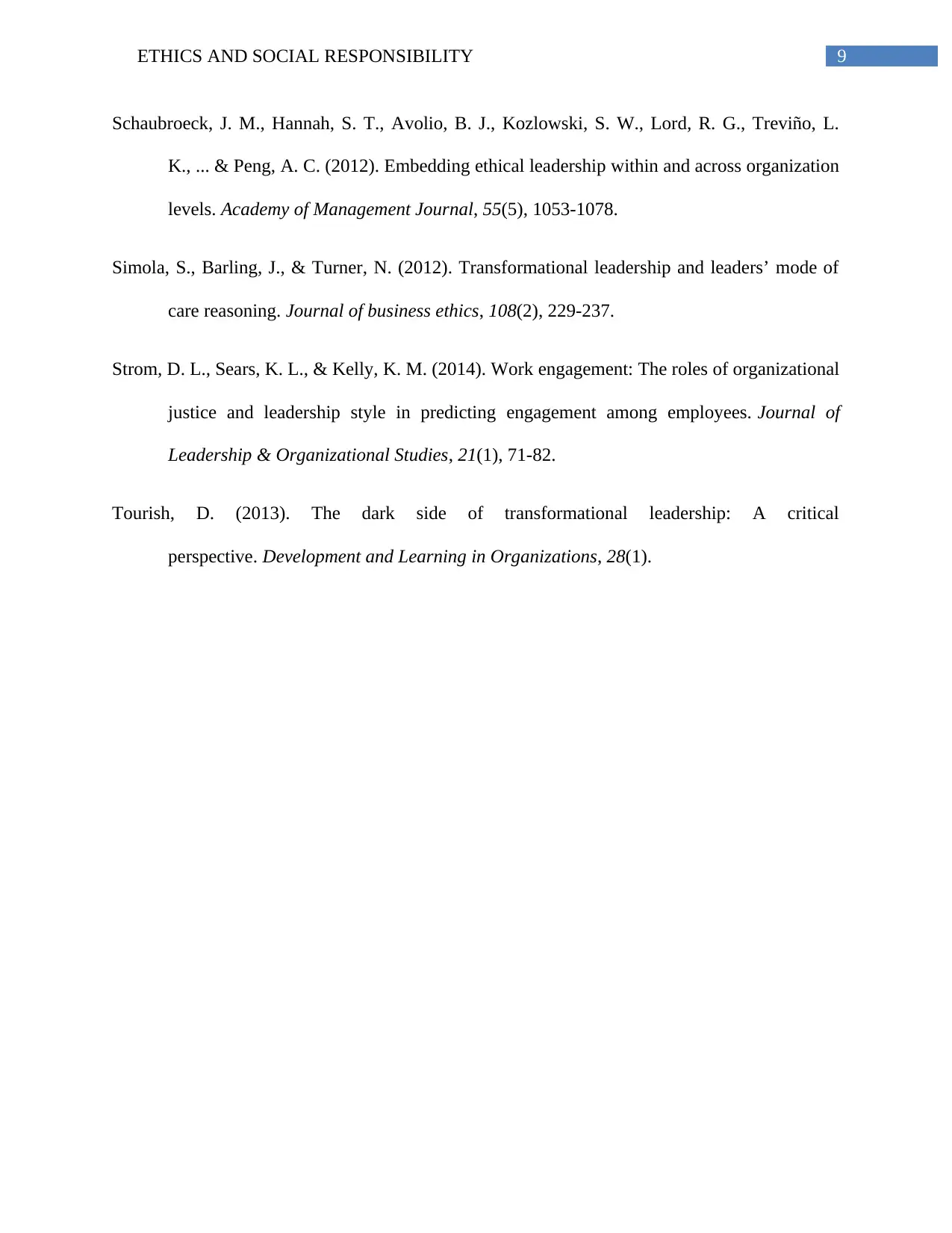
9ETHICS AND SOCIAL RESPONSIBILITY
Schaubroeck, J. M., Hannah, S. T., Avolio, B. J., Kozlowski, S. W., Lord, R. G., Treviño, L.
K., ... & Peng, A. C. (2012). Embedding ethical leadership within and across organization
levels. Academy of Management Journal, 55(5), 1053-1078.
Simola, S., Barling, J., & Turner, N. (2012). Transformational leadership and leaders’ mode of
care reasoning. Journal of business ethics, 108(2), 229-237.
Strom, D. L., Sears, K. L., & Kelly, K. M. (2014). Work engagement: The roles of organizational
justice and leadership style in predicting engagement among employees. Journal of
Leadership & Organizational Studies, 21(1), 71-82.
Tourish, D. (2013). The dark side of transformational leadership: A critical
perspective. Development and Learning in Organizations, 28(1).
Schaubroeck, J. M., Hannah, S. T., Avolio, B. J., Kozlowski, S. W., Lord, R. G., Treviño, L.
K., ... & Peng, A. C. (2012). Embedding ethical leadership within and across organization
levels. Academy of Management Journal, 55(5), 1053-1078.
Simola, S., Barling, J., & Turner, N. (2012). Transformational leadership and leaders’ mode of
care reasoning. Journal of business ethics, 108(2), 229-237.
Strom, D. L., Sears, K. L., & Kelly, K. M. (2014). Work engagement: The roles of organizational
justice and leadership style in predicting engagement among employees. Journal of
Leadership & Organizational Studies, 21(1), 71-82.
Tourish, D. (2013). The dark side of transformational leadership: A critical
perspective. Development and Learning in Organizations, 28(1).
1 out of 10
Related Documents
Your All-in-One AI-Powered Toolkit for Academic Success.
+13062052269
info@desklib.com
Available 24*7 on WhatsApp / Email
![[object Object]](/_next/static/media/star-bottom.7253800d.svg)
Unlock your academic potential
Copyright © 2020–2025 A2Z Services. All Rights Reserved. Developed and managed by ZUCOL.





